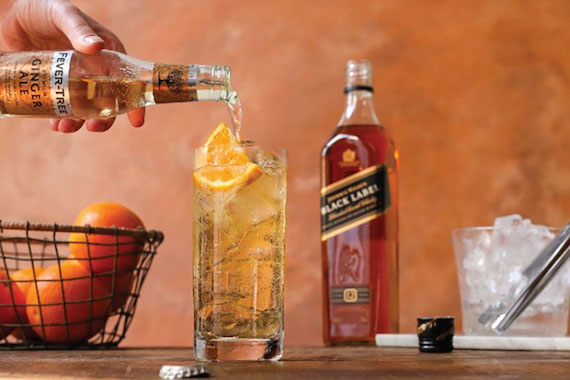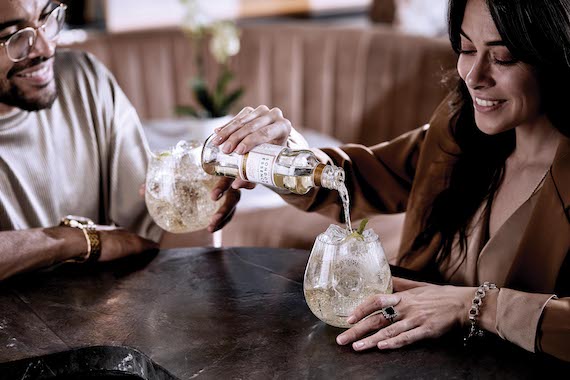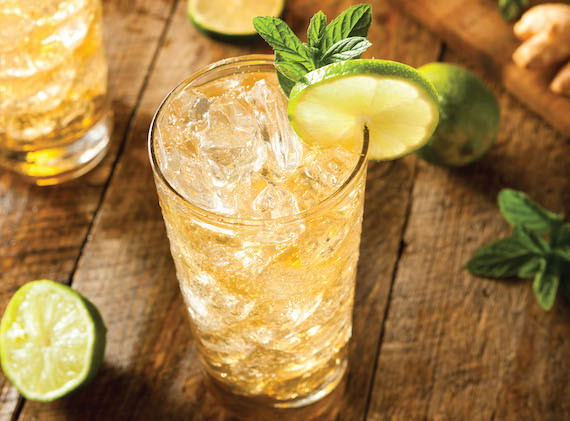Among those traditional carbonated mixers in line for a resurgence, some have a better shot than others (sorry, cream soda). Tonic water has certainly had its turn, and it looks like ginger ale may be next. Somewhat overlooked for quite some time – its fiery cousin ginger beer has been getting all the attention via drinks like the Mule and the Dark ’N’ Stormy, after all – there are various factors that have been driving sales of ginger ale recently, both for mixing and serving neat. The rise in popularity of the Highball is undoubtedly helping, as is growing demand for low and no-alcohol serves.
Ginger ale’s subtle ginger flavours, at least compared with your average ginger beer, make it a more versatile mixer, and the fact that it’s not being overlooked in the ranges of many cool, new soft drinks brands is beneficial too. Matt Mahatme, co-founder of mixer brand Lixir, says its example “has been the Steady Eddie of the range for us”. He describes ginger ale in general as “criminally underrated, a backbone in any bar fridge, but probably overshadowed slightly by ginger beer”.
That’s starting to change, at least. Market research provider Euromonitor International reported a global increase of 3.3% in volume sales of ginger ale in 2021, compared to 2020, with an increase of 5.7% in value. It forecast that 2022 would bring increases of 5.5% and 10.1% in volume and value, respectively.
At Double Dutch, co-founder Raissa de Haas is definitely noticing this. In London, for example, the brand’s ginger ale is the fastest growing in the range, increasing in distribution by 120% and 131% in volume. “Its versatility means that it’s often mixed with spirits, but it is also drunk alone as a refreshing, flavourful and low-calorie soft drink,” she says.
Market leader Schweppes reports similar success. “Schweppes Ginger Ale has seen significant growth versus previous years, particularly due to the out of-home recovery trend,” says Marina Nastyushenko, senior brand manager for Schweppes Great Britain.
Fever-Tree’s pair of ginger ales – in original and Spiced Orange – are also growing, according to global communications director Ollie Winters, who attributes this not only to consumer interest, but to the work done by spirits brands too. “There is no doubt that there is growing interest in the category among consumers, but also from spirits brands keen to position many of their dark spirits as long mixed drinks, seeing ginger ale as the ideal partner,” he says.

At Speciality Brands in the UK, head of education Nathan Shearer sees ginger ale’s value when combined with various spirits. “Ginger ale is an excellent mixer to lengthen many barrel aged spirits, especially in the whisky and rum categories, but it can also work with unaged spirits, for a lighter and fresher style of Highball,” he says, giving examples of spirits such as Tapatio Blanco tequila or Barsol Quebranta pisco.
But it’s with aged spirits that ginger ale really shines, he believes. “I think it works so well because it mirrors many of the notes that you find in barrel aged spirits – ginger, vanilla, clove, cinnamon – and accents them while also lengthening the drink. And the effervescence helps carry those aromas right out of the glass too,” he adds.
At The London Essence Co, cofounder Ounal Bailey agrees that ginger ale is in its element with aged spirits. “We see ginger ale doing particularly well in markets where there is a greater appreciation for whisky, for example Ireland and France, and also across Asia,” she says. “Our ginger ale is balanced by a particularly distinctive profile, with the addition of the anise and fennel distillate, which helps to bring out the character of dark spirits.”
For Bailey, ginger ale’s milder flavour, compared to ginger beer, is an asset when it comes to mixing. “It’s a fantastic drink, and allows for premium spirits like rum to shine through a little bit more than a ginger beer,” she says.
De Haas, meanwhile, sees the relative merits of both ginger-flavoured mixers. “There is a distinct difference between our ginger ale and ginger beer, and how they pair beautifully with different spirits,” she says. “Ginger ale can be more approachable for our consumers as a lighter, more versatile soda, whereas ginger beer provides real heat to a drinking experience, and stands up to a range of spirits when mixed.”
Mahatme agrees, seeing a place for both. “With our on-trade customers, having both is super-important to allow for a variety of drinks to be made,” he says. “Our ginger ale, for example, is best with a delicate spirit, while the ginger beer, being more fiery, lends itself to much punchier drinks.”
The success of one over the other can be a question of regionality too, he says, pointing out that Lixir’s ginger beer is particularly popular in Estonia, for example.
Fever-Tree’s Winters mentions these geographical considerations too. “Depending on the region, there are different levels of awareness of ginger ale and ginger beer,” he says. “In the US, for example, both ginger ale and ginger beer are well-understood categories, with Mule drinks in particular continuing to grow in popularity. In the UK, ginger ale is less well-known, but there is no doubt the category is gaining recognition with our customers, as well as with spirits brands investing in ginger-based drinks and serves.”

THE RISE OF THE HIGHBALL
If there’s one style of mixed drink that is helping to boost sales of ginger ale, it’s the Highball, the on-trend, elegant, light and refreshing serve that’s been steadily on the rise recently. It’s simple enough for making at home – an increasingly important consideration in recent years – while customisable enough to keep things interesting for bartenders. And it’s a wonderful showcase for both the spirit and the mixer, keeping the brands happy too.
“We are excited about the continued emergence of the Highball, enabling consumers to sample an even wider range of our mixers, from our ginger ale to our lemonades and our premium soda range, all of which create fantastic Highball cocktails,” says Winters.
Mahatme agrees that the benefits include broadening the horizons of drinkers. “The rise of the Highball has been great for sales, but also allowing for consumers to try drinks they may not have had before,” he says. “We are big champions of the ‘two-part pour’ – a long drink made up of a single spirit and a mixer. With our flavoured mixers this allows for endless combinations.”
At Speciality, Shearer has noticed the rise of this style of drink too, and sees its potential. “There has definitely been an increase in Highball-style drinks over the past few years, partly due to an influx of Japanese izakaya style restaurants in the UK, championing the Japanese Highball with brands like Nikka,” he says. “Whenever we get a new product or start working with a new brand, we will always try to create a handful of simple Highball-style serves that work in multiple situations. It’s a great way to introduce people to the brand or category in a flavourful and also simple way, and it’s amazing the complexity that you can get from a beautifully crafted spirit and a well made mixer.”
Fever-Tree is joining in on the Highball trend too. “This winter will see an increasing focus on promoting Highball serves, such as our collaboration with Johnnie Walker that will see us take over Bar 31 at the Shangri-La Hotel in The Shard, with a new Highball serve at the centre of the offering.”
Among the five bespoke winter Highball cocktails created for this collaboration, including various FeverTree mixers, is the Johnnie & Ginger, combining Johnnie Walker Black Label with Fever-Tree Ginger Ale.
Cognac Frapin, meanwhile, has long known about the merits of serving its cognac Highball-style, with ginger ale – a staple serve at brand events. “It’s very simple and tasty, with a lot of freshness,” says communications manager Thomas Soret. “The light notes of ginger match very well with Cognac Frapin 1270, although it’s important to use an artisanal ginger ale that isn’t too sweet, with more finesse.”
Double Dutch’s De Haas points out a characteristic of the Highball that makes it particularly suited to contemporary consumers. “Highballs allow for a longer, lighter drink and appeal especially to a younger Millennial and Gen Z audience who are looking to monitor their alcohol intake, with the ability to dilute spirits to their taste,” she says.
Of course, when served on its own, ginger ale is well placed to cater to the growing demand for non-alcoholic drinks too. “Our Delicate Ginger Ale is a great option for those looking to decrease their alcohol intake, which is just as delicious as a solus drink,” says The London Essence Co’s Bailey.
Whether served as a Highball or as a non-alcoholic option, the time for oft overlooked ginger ale might indeed have arrived.




